6 Best Grass Types for Las Vegas
BY MELANIE JOSEPH | MAY 25TH, 2023 | LAS VEGAS, LAWN CARE, NEVADALas Vegas, the shimmering jewel of the Nevada desert, is famous for its bright lights, world-renowned casinos, and luxurious hotels. But beyond the glitz and glamour lies a challenging environment for growing a lush, green lawn. With temperatures soaring to triple digits during the scorching summer months and water in short supply, choosing the right grass type is crucial for any homeowner in Sin City.
Thankfully, these 6 best grass types for Las Vegas are well-suited to the area’s hot and arid climate. From the drought-resistant buffalograss to the heat-tolerant Zoysiagrass, each variety has unique characteristics that can withstand the harsh desert sun.
- Warm-Season vs. Cool-Season Grasses
- 6 Warm-Season and Cool-Season Grasses for Las Vegas
- FAQ About Las Vegas Grass Types
Warm-Season vs. Cool-Season Grasses
Las Vegas has a unique climate that can be challenging for plants, especially grasses. When selecting the best grass type for your lawn in the Mojave Desert region, it’s essential to understand their growth patterns and requirements. Categorizing grasses into two general groups based on their temperature preferences simplifies the selection process and helps you make an informed decision.
Warm-season grasses: Grass types like bermudagrass, buffalograss, and Zoysiagrass are the best fit for Las Vegas lawns. These warm-season grasses grow actively during the hot summer months when temperatures range between 80 to 95 degrees Fahrenheit. They can tolerate drought and high temperatures, making them perfect for the Las Vegas environment. Late spring or early summer is the perfect time to plant these grasses.
Cool-season grasses: These grasses, which include fine fescue, Kentucky bluegrass, and tall fescue, prefer colder temperatures ranging from 60 to 75 degrees Fahrenheit. These grass types are best suited for spring and fall when the temperatures are milder. However, they may struggle during the hot summer months, which are prevalent in Las Vegas.
Picking the perfect grass variety that suits your lawn’s specific characteristics and the prevailing climatic conditions is essential in maintaining a flourishing and visually appealing lawn all year long.
6 Warm-Season and Cool-Season Grasses for Las Vegas
With a hot and dry climate, Vegas offers a unique challenge for homeowners who want a lush and beautiful lawn. Fortunately, the city is in a transition zone, allowing both warm-season and cool-season grasses to be planted.
But due to the scarcity of water coming from the Colorado River, you need the best grass type that can withstand the hot summers of Southern Nevada while also being water-efficient.
1. Bermudagrass
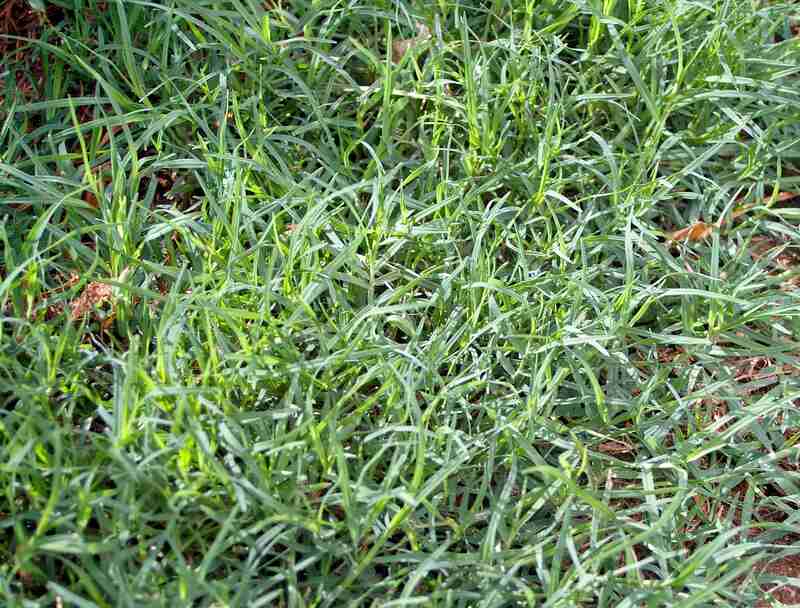
Photo Credit: Bidgee / Wikimedia Commons / CC BY-SA 3.0
This versatile grass species is incredibly hardy and can easily withstand the harsh, arid climate of Las Vegas. With its stunning appearance and resistance to high foot traffic, bermudagrass can be used in a variety of settings, from residential lawns to athletic fields and golf courses.
In terms of appearance, bermudagrass boasts a rich green color and a fine texture that is pleasant to the touch. Its density and ability to spread quickly make it ideal for those who want a lush, full lawn without having to wait years for it to fill in. With proper care, this drought-tolerant grass can thrive and enhance your Vegas lawn for many years.
Classification: Warm-season grass
Spreads by: Stolons and rhizomes
Shade tolerance: Low – but some bermudagrass cultivars require more direct sun exposure than others
Drought tolerance: High – extended periods of drought may cause it to turn brown and become dormant
Foot traffic tolerance: High
Maintenance needs: Moderate to high – you’ll have to mow and fertilize more often
Recommended mowing height: 1-2 inches – during periods of extreme drought or heat, you may have to increase the mowing height to retain moisture
Potential for disease: Moderate resistance – may be susceptible to leaf spot, spring dead spot, brown patch, and dollar spot
Potential for pests: Low resistance – can be prone to hunting billbugs, mole crickets, white grubs, and armyworms
Soil pH: 6-6.5
Soil type: Prefers loam soil but can grow in most types of soil
Other notes: To achieve the best results when reseeding this grass type, it’s essential to sow during the optimal temperature range of 70 to 90 degrees Fahrenheit, typically occurring in late spring or early summer.
2. Buffalograss
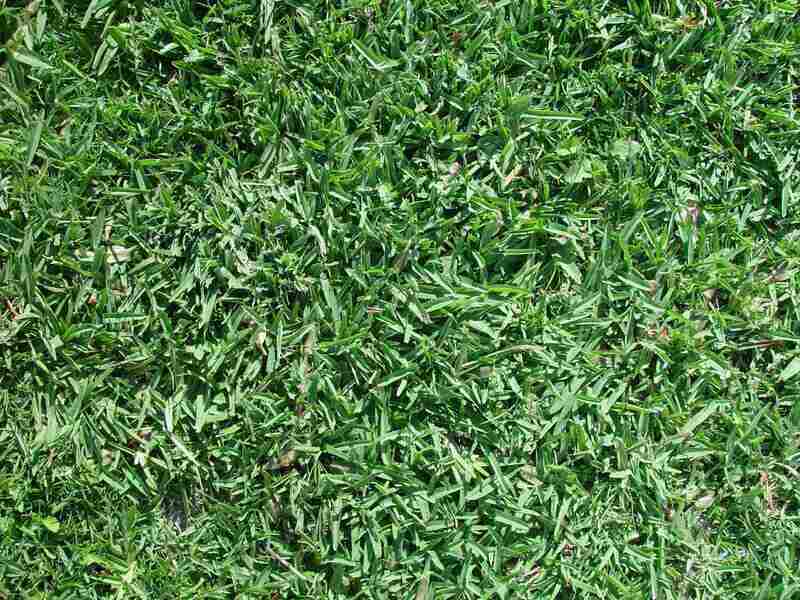
Photo Credit: Pixnio
Known for its hardiness and low-maintenance requirements, buffalograss has a high drought tolerance and an ability to withstand the harsh desert climate. In fact, it can tolerate temperatures up to 110 degrees Fahrenheit, making it perfect for the scorching Las Vegas summers.
This warm-season grass has a fine texture and a greenish-blue color that adds a natural look to any landscape. Its low growth pattern makes it perfect for high-traffic areas such as playgrounds, golf courses, and sports fields. Since it requires little water once established, buffalograss is perfect for Southern Nevada, where water conservation is paramount.
Classification: Warm-season grass
Spreads by: Stolons
Shade tolerance: Very low
Drought tolerance: High – it doesn’t need more than 25 inches of water a year
Foot traffic tolerance: Very low
Maintenance needs: Low
Recommended mowing height: 2-4 inches
Potential for disease: Moderate resistance – may be prone to dollar spot, brown patch, spring dead spot, and leaf spot
Potential for pests: Low resistance – can be susceptible to mole crickets, armyworms, hunting billbugs, and white grubs
Soil pH: 6.5-7.5
Soil type: Prefers well-drained, fertile, loamy, and clay soil
Other notes: This grass variety is not suitable for sandy and saline soils. While it’s relatively low-maintenance, it can be hard to cultivate buffalograss from seed. But it can survive with little to no fertilizer, herbicides, or pesticides.
3. Fine Fescue
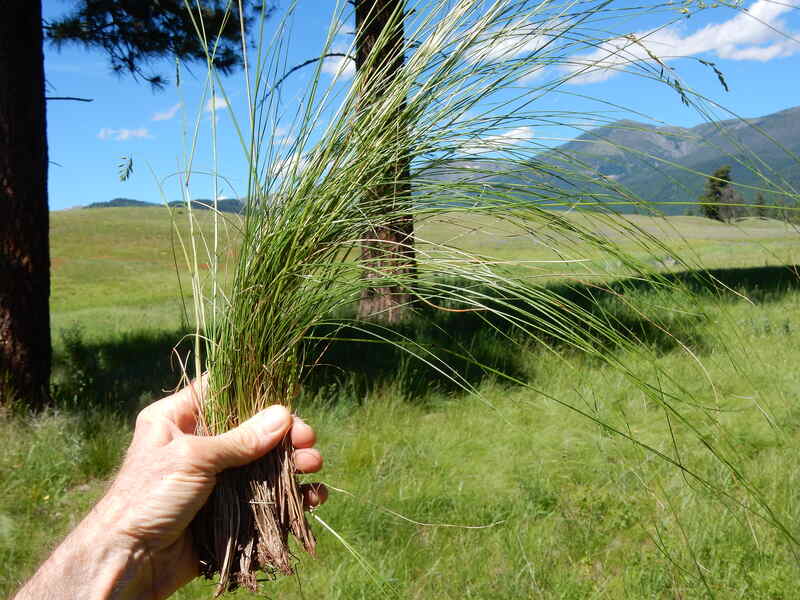
Photo Credit: Matt Lavin / Flickr / CC BY-SA 2.0
With its fine texture, soft feel, and green color, fine fescue is often used in residential lawns, golf courses, and parks. This grass type is highly tolerant of drought and cold temperatures, which makes it a perfect choice for the unpredictable climate of Las Vegas.
While it’s commonly used in shaded areas, fine fescue also can thrive in sunny spots with proper care. Since it requires minimal maintenance, it’s perfect for homeowners who don’t have the time or resources to dedicate to a high-maintenance lawn. Plus, its deep root system allows it to absorb nutrients and water more efficiently.
Classification: Cool-season grass
Spreads by: Creeping red fescues spread through short rhizomes, while other fescues have bunch-type growth
Shade tolerance: Moderate to high
Drought tolerance: Moderate to high
Foot traffic tolerance: Low to moderate
Maintenance needs: Low
Recommended mowing height: 1.5-3 inches
Potential for disease: Moderate resistance – can be prone to dollar spot, red thread, summer patch, leaf spot, and downy mildew
Potential for pests: Moderate resistance – mostly susceptible to billbugs, chinch bugs, grubs, and sod webworms
Soil pH: 5.5-6.5
Soil type: Prefers well-drained, sandy soil but can tolerate infertile soils
Other notes: While it has relatively good disease resistance, note that over-fertilization can lead to thatch buildup and increase the risk of disease.
4. Kentucky Bluegrass
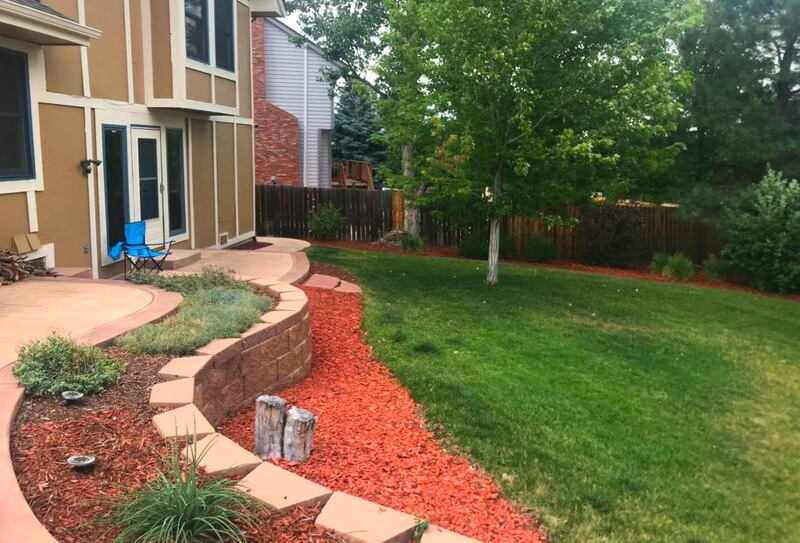
Photo Credit: Brenda Ryan / Wikilawn
While it may not be the first type of grass that comes to your mind when thinking of your Vegas lawn, this cool-season grass is actually a great option as it can thrive in the desert climate. Known for its rich, deep green color and fine texture, Kentucky bluegrass is perfect for outdoor entertaining and relaxation.
Note, though, that this grass variety may need more water and maintenance than the other grass types suitable for Nevada. But under ideal conditions, it can give you a dense and beautiful lawn that will not die during droughts and extreme dry spells.
Classification: Cool-season grass
Spreads by: Rhizomes
Shade tolerance: Low to moderate – prefers full sun
Drought tolerance: Moderate
Foot traffic tolerance: Low to moderate, but recuperates well
Maintenance needs: Moderate
Recommended mowing height: 2-3 inches – mow taller during summer
Potential for disease: Moderate to high – mostly prone to fairy rings, snow molds, dollar spot, summer patch, leaf spot, and necrotic ring spot
Potential for pests: Moderate to high – can be susceptible to grubs, greenbugs, bluegrass billbugs, sod webworms, armyworms, and chinch bugs
Soil pH: 6-7
Soil type: Well-drained, fertile soils
Other notes: You can mix it with other grass types, like tall fescue, to create a lush lawn. However, you’ll need to water it regularly due to its relatively shallow root system. But newer cultivars are generally hardier and more disease-resistant.
5. Tall Fescue
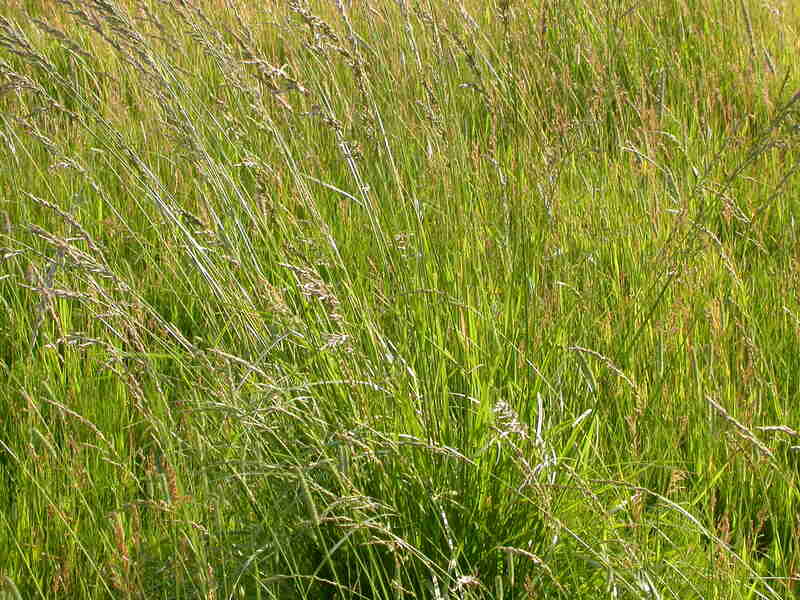
Photo Credit: Matt Lavin / Flickr / CC BY-SA 2.0
Another popular cool-season grass known for its adaptability and resilience, tall fescue can thrive in Southern Nevada’s climate. But while this grass type can withstand foot traffic, it can’t easily recover from wear. So, if you have children and pets who love running around the yard, this is not the grass type for you.
With its deep green color and fine texture, tall fescue can add a touch of elegance to any lawn. It’s tolerant of a wide range of environmental conditions, including drought, heat, and cold. It thrives in moderate temperatures and can tolerate shade. Plus, it can access nutrients and water deep in the soil with its deep root system, allowing it to survive periods of low rainfall.
Classification: Cool-season grass
Spreads by: Tillers (Bunch forming)
Shade tolerance: Moderate to high
Drought tolerance: Moderate
Foot traffic tolerance: Moderate – doesn’t recover easily from wear
Maintenance needs: Moderate
Recommended mowing height: 2-4 inches (Refer to the local state guidelines for your particular cultivar, as several types of tall fescue grass tend to flourish when mowed at a taller height.)
Potential for disease: Low to moderate – can be prone to leaf spot, brown patch, and seedling disease
Potential for pests: Low to moderate – mostly susceptible to armyworms, cutworms, grubs, and sod webworms
Soil pH: 5.5-6.5
Soil type: Prefers clay soil but grows in most soil types
Other notes: Consider sowing new grass seeds every few years to address patchy and thinning areas. Applying fertilizer just once during the fall months, preferably in September or November, can help ensure optimal growth and vibrancy of your lawn.
6. Zoysiagrass
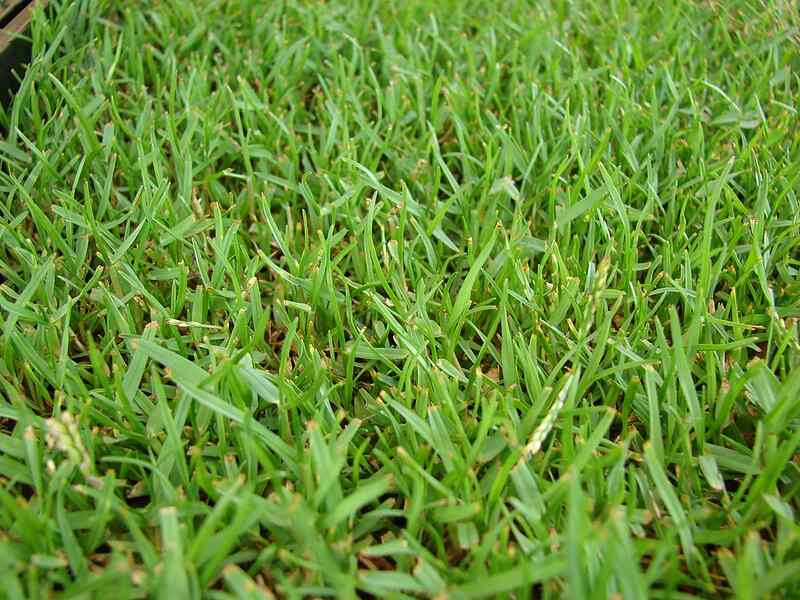
Photo Credit: Forest & Kim Starr / Wikimedia Commons / CC BY 3.0 US
Known for its fine texture, tight growth pattern, and beautiful emerald-green color, Zoysiagrass can increase the curb appeal of any property. It’s well-suited to the arid and hot climate of Las Vegas due to its heat and drought tolerance, as well as its ability to thrive in both sun and partial shade.
Commonly used in residential lawns, parks, and golf courses, this slow-growing grass can tolerate heavy foot traffic and recover quickly from damage. It requires less water than other grass types, making it one of the best options for conserving water.
Classification: Warm-season grass
Spreads by: Rhizomes and stolons
Shade tolerance: Low to moderate – it requires more direct sun exposure
Drought tolerance: High – but you’ll have to give it supplemental watering during extended periods of drought
Foot traffic tolerance: High
Maintenance needs: Low to moderate
Recommended mowing height: 1-2.5 inches
Potential for disease: Moderate resistance – can be susceptible to spring dead spot, fairy wings, rust, curvularia, dollar spot, root decline, brown patch, leaf spot, and powdery mildew
Potential for pests: Moderate resistance – common pests include chinch bugs, sod webworms, hunting billbugs, armyworms, mole crickets, grubs, and nematodes
Soil pH: 6-6.5
Soil type: Prefers well-drained, loamy soil but can still grow in most soil types
Other notes: Despite its deep root system and ability to tolerate compacted soil, Zoysiagrass may not thrive as much in these conditions as it would in well-aerated soil.
Nevada Restricts Use of Non-Functional Turfgrass
Nevada passed a law (Assembly Bill 356) restricting the use of non-functional turfgrass in certain areas of the state. The law aims to conserve water, promote sustainability, and reduce water waste in urban areas.
Under the law, non-functional turf is defined as any turf used for aesthetic or ornamental purposes rather than functional ones, such as sports fields or parks. The law prohibits the installation of non-functional turf in new developments or re-landscaping projects in certain areas of Nevada. It also requires existing non-functional turf to be removed and replaced with water-efficient landscaping by Jan. 1, 2027.
The areas where the law is in effect are:
- Colorado River Basin – includes Clark County, which is home to Las Vegas
- Lake Tahoe Basin – includes parts of Washoe County and Carson City
The law exempts certain types of properties from the restriction, including single-family homes, golf courses, and cemeteries.
FAQ About Las Vegas Grass Types
If you’re looking to have a lush and healthy yard, a soil test is highly recommended. Since Nevada’s climate and soil conditions can make it challenging to grow certain plants and grasses, knowing what nutrients your soil lacks can help you decide which plants to grow and how to care for them.
Soil tests can determine your soil’s pH level, which is important because it affects the availability of nutrients to your plants. They also can tell you if your soil lacks essential nutrients, such as potassium, nitrogen, and phosphorus.
Fortunately, soil testing is a straightforward and inexpensive process. You can purchase a home testing kit or send your soil sample to a testing laboratory for analysis. The report will contain specific recommendations on how to amend your soil to optimize plant growth.
Among the top choices for a low-maintenance yard in Las Vegas are buffalograss, fine fescue, and Zoysiagrass. These grass types are drought-tolerant and require less watering compared to other grasses. They also have the added benefit of being more heat-resistant, making them ideal for Southern Nevada summers.
Since Las Vegas has a harsh desert climate, watering your lawn properly is crucial for keeping it healthy and lush. You also should remember to use water efficiently to help conserve it. Here are some tips to ensure efficient watering of your lawn:
- Water your lawn when temperatures are cooler in the morning or evening. This way, you’ll avoid losing water due to evaporation.
- Deliver water directly to the root zone by using a drip system or low-volume spray. Apart from saving water compared to a traditional sprinkler system, you’ll also be reducing water loss through evaporation or runoff.
- Encourage deeper root growth and make your lawn more resilient to drought by watering it deeply and infrequently. Watering for longer periods but less frequently is more effective than short, frequent watering.
- Check for any water restrictions in your area and follow them to help conserve water while avoiding fines and penalties.
- Depending on the season, adjust your watering schedule and amount accordingly. During the cooler months, your lawn needs less water.
Choose the Right Grass for Your Las Vegas Landscape
Having the right grass type for your Sin City lawn is crucial in ensuring its long-term health and beauty. With the increasing water scarcity concerns, you must select a drought-resistant variety that can survive on restricted watering schedules.
Fortunately, these warm-season and cool-season grasses can thrive in the hot and arid climate of Southern Nevada. By considering factors such as water and maintenance requirements, you can have the best grass type ideal for your lawn’s unique qualities. For a low-maintenance yard, pair your turfgrass with the best desert landscaping plants and trees suitable for Las Vegas.
Reach out to a local lawn care pro today for help in selecting the right grass that can add value and curb appeal to your property.
Main Image Credit: Lawn, Las Vegas / Dan Perry / Flickr / CC BY 2.0